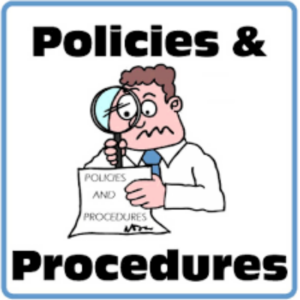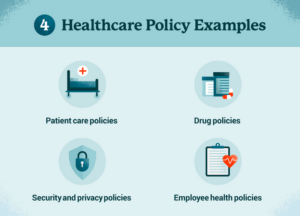Organizational Policies and Practices to Support Healthcare
 Introduction: The healthcare landscape is in a perpetual state of flux, continually adapting to the dynamic requirements of patients, healthcare institutions, and the communities they serve.
Introduction: The healthcare landscape is in a perpetual state of flux, continually adapting to the dynamic requirements of patients, healthcare institutions, and the communities they serve.
Healthcare policies and practices are regularly revised to align with the evolving demands dictated by business models striving to maintain profitability while ensuring the continued provision of community healthcare.
While standardized healthcare policies enhance efficiency and cost-effectiveness for routine care, they can sometimes impede nurses’ capacity to deliver personalized, ethical patient care (Kelly & Porr, 2018).
In the face of this challenge, nurses must remain cognizant of the potential ethical consequences of their actions, seek solutions to ethical dilemmas in nursing, and prioritize patient needs (ANA, 2015).
Nursing leadership plays a critical role in supporting nurses in navigating these challenges and ensuring that their well-being and ethical responsibilities are prioritized.
Impact of Competing Needs on Policy Development
The healthcare arena demands ongoing updates to policies and procedures, which could transpire on a weekly, monthly, or even daily basis. These changes are contingent on various factors, including nurse staffing, physician availability, and the operational status of other ancillary departments. The development of healthcare policy must address these competing needs to ensure that policies not only enhance efficiency but also safeguard the emotional well-being of nurses. In the context of my outpatient oncology center, fluctuations in staffing levels in ancillary departments have a ripple effect on the infusion nurses. When operators are absent, infusion nurses must shoulder the responsibilities of managing patient messages and returning calls. Shortages in the lab prompt infusion nurses to draw patients’ labs before administering treatment. If the infusion scheduler is unavailable, infusion nurses step in by ensuring patients receive their upcoming appointments.

Struggling to meet your deadline?
Get your assignment on Organizational Policies and Practices to Support Healthcare done by certified MDs and PhDs in the USA. ORDER NOW!
Absences among pharmacy technicians necessitate infusion nurses to fill in and prepare chemotherapy admixtures. In the absence of a physician, infusion nurses often take on the roles of patient assessment and treatment administration. These daily adjustments cater to the office’s demands and patients’ needs but significantly add to the already demanding roles of infusion nurses, amplifying the risk of nurse burnout. Nurse staffing challenges and the added responsibilities can lead to compassion fatigue and exacerbate the risk of burnout, which is a significant issue in nursing today. Emotional intelligence in nursing plays a pivotal role in self-awareness. Understanding one’s emotional intelligence can fortify relationships, improve decision-making, and enhance nurse emotional well-being (Walden, 2009). 
While nurses bear the ethical duty of caring for their patients, they also owe a similar commitment to themselves, encompassing responsibilities to safeguard their own health and safety, uphold their integrity and character, maintain professional competence, and perpetually foster professional growth in nursing (ANA, 2015). The mounting workload imposed on infusion nurses could potentially engender ethical dilemmas in nursing. Nurses must be astute in recognizing when their limits are being pushed and must be prepared to advocate for their well-being and that of their patients, thereby preventing ethical conflicts and ensuring quality patient care (Kelly & Porr, 2018).
Policy Responses to Address Competing Needs
Given the intricacies of healthcare settings, it is imperative for nurses to remain vigilant for ethical issues that may arise. Leadership in healthcare settings is indispensable for fostering a healthy work environment, as nurturing such an environment for nurses concurrently nurtures a healthy environment for patients. It is paramount to acknowledge that nurses are already performing to their fullest capabilities, and adding more responsibilities to their daily routines can exacerbate ethical risks.
Effective nursing leadership ensures that ethical awareness becomes an integral component of daily nursing practice, supporting nurses in making morally sound decisions in the best interest of both the patient and their own well-being (Milliken, 2018). While ethical nursing practice often pertains to making morally sound decisions in the best interest of the patient, the American Nurses Association underscores that nurses also bear an ethical responsibility to themselves. As professionals engaged in assessing, intervening, evaluating, protecting, promoting, advocating, educating, and conducting research for the health and safety of individuals and society, nurses must apply the same level of care to their own health and safety (ANA, 2015). This can be done through nurse advocacy and ongoing professional growth in nursing, ensuring that nurses remain resilient and competent in their roles.
The Importance of Emotional Intelligence for Nurses
Emotional intelligence in nursing is crucial for managing stress, making sound decisions, and handling ethical dilemmas in nursing practice. By recognizing and regulating their own emotions, nurses are better equipped to handle the challenges of nursing, including compassion fatigue and nurse burnout. Training in emotional intelligence helps nurses develop better communication skills, empathy, and self-awareness, which is essential for improving the nurse-patient relationship. Moreover, emotional intelligence empowers nurses to maintain their nurse well-being, making it an important tool for preventing burnout and ensuring high-quality patient care.
Ethical Responsibilities of Nurses
Nurses’ ethical responsibilities go beyond the duty of caring for their patients; they must also take responsibility for their own health and well-being. In the context of healthcare staffing challenges and high patient demand, it is vital for nurses to recognize when they are overburdened and take action to advocate for their own health. Workplace ethics for nurses demands that nurses not only provide care with compassion but also take steps to preserve their emotional and physical health. Nurses must be aware of ethical dilemmas in nursing that arise when their work environment compromises their health, and they must advocate for policies that prevent burnout and enhance the workplace culture in healthcare.
Nurse Advocacy and Self-Care
Nurses are often caught in a tension between providing personalized patient care and safeguarding their own well-being. Therefore, nurse advocacy and self-care are essential to prevent the negative effects of stress and burnout. Advocating for better staffing levels, more manageable workloads, and supportive policies is critical in reducing the risk of nurse burnout. Nurses must also engage in self-care practices that address both their mental and physical health needs, ensuring that they can continue to provide excellent care without compromising their health.
Leadership and Organizational Support for Nurses
Leadership in healthcare settings plays a pivotal role in addressing nurse staffing issues and supporting nurse well-being. Effective leadership fosters a healthy work environment where nurses feel valued, supported, and equipped to handle the challenges of their roles. Healthcare institutions should develop policies that help prevent burnout, address ethical dilemmas in nursing, and enhance the nursing competence of their staff. Leaders should ensure that nurses have the resources they need to maintain their professional growth in nursing, preventing burnout and improving the overall workplace culture in healthcare.
Conclusion
Nurses should not compromise their health or safety needlessly, as burnout and compassion fatigue can severely impede their ability to provide quality care to their patients. Consequently, nurses must remain cognizant of their emotional intelligence and be prepared to advocate for their ethical well-being, thus ensuring the delivery of superior patient care. By developing policies that prioritize both the health of nurses and the patients they serve, healthcare institutions can support their nursing staff in maintaining nursing competence and providing high-quality care, reducing ethical conflicts, and creating a workplace culture that is sustainable and compassionate.
References:
American Nurses Association. (2015). Code of ethics for nurses with interpretive Statements. Silver Spring, MD: Author, Retrieved from https://www.nursingworld.org/coe-view-onlyLinks to an external site.
Kelly, P., & Porr, C. (2018). Ethical nursing care versus cost containment: Considerations to enhance RN practice. OJJN. Online Journal of Issues in Nursing, 23(1), Manuscript 6. Doi:10.3912/ONJJ.Vol23No01Man06. Retrieved from http://ojnn.nursingworld.org/ManMenuCategories/ANALinks to an external site.
Marketplace/ANAPeriodicals/OJNN/TableofContents/Vol-23-2018/No1-Jan2018/Ethical-Nursing-Cost-Containment.html
Milliken, A. (2018). Ethical awareness: What it is and why it matters. OJIN:Online Journal of Issues in Nursing. 23(1). Manuscript 1. Doi:10.3912/OJIN.Vol23.No01.Man01. Retrieved from http://ojnn.nursingworldLinks to an external site..
Org/MainMenuCategories?ANAMarketplace/ANAPeriodicals/OJNN/TableofContents/vol-23-2018/No1-Jan2018/Ethical-Awareness.html
Walden University, LLC. (Producer). (2009). Working with Individuals. [Video file].
Baltimore, MD: Author.
ORGANIZATIONAL POLICIES AND PRACTICES TO SUPPORT HEALTHCARE ISSUES SAMPLE 3
Balancing Competing Needs in Healthcare
Introduction
As nurses, we encounter ethical dilemmas in nursing on a daily basis. It’s crucial to recognize that ethics and laws, while interconnected, are distinct, and we must not conflate the two. In the healthcare domain, ethical dilemmas in nursing are a frequent occurrence, fostering nurses’ adaptability and resilience in handling such situations. When healthcare professionals confront ethical dilemmas, they are consistently guided by the principle of acting in the best interests of the patient (Laureate Education, 2012). Maintaining ethical nursing practice is essential, as nurses are responsible for ensuring patient care is both safe and effective, even in challenging circumstances.
At present, a national healthcare issue that is transcending borders and becoming a global concern is the shortage of nurses in the workforce. Nursing shortages in numerous healthcare facilities have multifaceted repercussions on the quality of care provided. Overwhelming patient assignments contribute to dissatisfied and burnt-out staff, subsequently impacting patient satisfaction and safety (Ingram & Powell, 2018). Ensuring patient safety is the foremost objective of healthcare. Over the years, many policies pertaining to safety have been revamped to secure a safer working environment for both nurses and patients amidst the nurse staffing challenges and nurse burnout (Yang et al., 2015). These challenges underscore the importance of workplace ethics for nurses and the need for policies to prevent burnout in healthcare settings.
Policy Development to Address Nursing Shortages
Leaders, including unit managers and directors, must strive to strike a harmonious balance to retain nursing staff. They should gain a comprehensive understanding of the equilibrium between the demands placed on the staff and the complexities of patient acuity. Achieving this balance can significantly alleviate staff burnout and enhance staff retention in healthcare facilities. The needs for patient care vary significantly across different units. For example, a patient in the Intensive Care Unit (ICU) will require a higher level of care compared to a patient on the Mother-Baby/Postpartum unit. The acuity levels for each patient are communicated to the charge nurses and managers to ensure the appropriate assignment of safe nurse-patient ratios on the unit. Acuity is assessed using specialized tools designed to determine precise nurse-patient ratios. The fundamental purpose of these acuity tools is to enhance nurse satisfaction with their patient assignments, thereby improving overall nurse well-being and professional growth in nursing (Ingram & Powell, 2018). 
In the context of nursing competence and healthcare staffing challenges, policies addressing nursing shortages are crucial for maintaining a high standard of patient care. These policies ensure that nurses are not overburdened and that safe, manageable workloads are maintained. The role of nursing leadership in creating and implementing these policies is key to addressing the staffing crisis and safeguarding nurse emotional well-being.
Policies Addressing Nursing Shortages
The American Nurses Association (ANA) stands as a bulwark protecting nurses from unsafe working conditions. They have established policies and standards to safeguard the workforce in potentially hazardous working environments. Federal regulations have also been implemented to support nursing staff in securing safer working conditions. The overarching goal of these policies is to ensure patient safety and maintain manageable workloads in healthcare facilities. In my home state, staffing laws are in place; however, the utilization of patient acuity tools in my facility further assists in creating safe and equitable nurse assignments across all units (ANA, 2015). These efforts align with the broader aim of healthcare burnout prevention, ensuring that nurses are adequately supported in their work, which in turn enhances the overall healthcare work environment.
Conclusion
Balancing the competing needs of nurses and patients in healthcare settings is a complex task, but one that is essential for ensuring the delivery of high-quality patient care. Policies that address nursing shortages, nurse burnout, and staff retention are vital to creating a healthy work environment where nurses can thrive. By ensuring appropriate nurse-patient ratios, providing professional growth in nursing, and implementing effective leadership in healthcare settings, healthcare institutions can better meet the demands of both their staff and patients. Nurses must also continue to advocate for themselves and their patients, prioritizing nurse emotional well-being and upholding the standards of ethical nursing practice.
References
American Nurses Association. (2015). Code of ethics for nurses with interpretive statements. Silver Spring, MD: Author. https://www.nursingworld.org/coe-view-onlyLinks to an external site.
Ingram, A., BSN, RN-BC, & Powell, J., BSN, RN. (2018, April 18). Patient acuity tool on a medical-surgical unit. https://www.americannursetoday.com/patient-acuity.com
Laureate Education (Producer). (2012). Ethical, Moral, and Legal Leadership [Video file]. Baltimore, MD: Author.
Yang, P., Hung, C., & Chen, Y. (2015). The impact of three nursing staffing models on nursing outcomes. Journal of Advanced Nursing (John Wiley & Sons, inc.), 71(8), 1847–1856.
https://doi-Links to an external site.org.ezp.waldenulibrary.org/10.1111/jan.12643
Navigating the Complex Landscape of Healthcare Costs and Technology
Introduction
Complaints regarding the escalating costs within the healthcare industry have become a pervasive concern in today’s healthcare landscape. This concern is exacerbated by the presence of competing needs, particularly evident in the doctor-patient relationship and the increasing demands for quality time between healthcare providers and patients. In this context, Kelly & Porr (2018) have noted a significant and rapid rise in healthcare expenses, primarily attributed to the transition from analog to digital healthcare delivery. The transformation to a digital model is deemed costly yet indispensable for achieving the desired outcomes in modern healthcare, as underscored by the American Nurses Association (ANA, 2015). Consequently, the development of healthcare policies has become a formidable challenge due to these mounting costs, with each policy perceived to have a potentially detrimental impact on healthcare.
Impact of Competing Needs on Policy Development
This predicament has given rise to an ethical dilemma in nursing and the broader healthcare sector. While technology has undeniably addressed complex medical issues and facilitated the commercialization of previously unavailable drugs, it has also led to challenges in healthcare accessibility. Advanced technological tools for internal body examination have expedited the diagnosis of diseases like cancer (Barba et al., 2021). In theory, this signifies significant progress toward better patient care and the eradication of some of the deadliest diseases globally. However, the growth of technology has made healthcare less accessible, especially without insurance coverage. Policymakers must explore avenues to enhance financing for research and therapy to ensure that individuals suffering from various diseases can access the care they need.
Specific Competing Needs Impacting Healthcare Access
The ramifications of these competing needs are multi-faceted. Technology has significantly improved access to medical data and information, primarily through the digitization of healthcare records. The digital revolution has brought forth the capability for healthcare professionals to access patient data from virtually any location. Healthcare practitioners can now swiftly exchange medical data via intranets and the internet, thereby enhancing patient care. Patients can conveniently view their test results via electronic health records on patient portals without having to contact the doctor’s office (“Intelligence Retinal Imaging Systems,” n.d.). However, this convenience has also brought about challenges related to data security and breaches, as care teams rely on the most up-to-date information for decision-making.
Furthermore, technology has the potential to streamline administrative tasks, reducing the time that office personnel spend on phone calls and paperwork. Portability, however, remains a challenge with technological requirements. Many technology companies are beginning to address this issue by offering electronic health record connectors to facilitate the adoption of new technologies. Policymakers must contemplate how to increase access to care to ensure that those in need receive the assistance they require. They must strike a balance between these and other competing objectives to devise effective plans for addressing healthcare issues.
Policy Responses to Address Technology and Healthcare Costs
Additionally, technology has enhanced access to care, a critical aspect of high-quality healthcare delivery. The barriers to healthcare access often lead to delays in treatment due to physical, geographical, and financial constraints faced by patients (AlQudah et al., 2021). Advantaged populations are also affected, and it is imperative for clinicians to provide them with solutions that leverage healthcare technology (Healthmanagement.org, 2020). Consequently, policymakers must focus on establishing regulations that limit how telehealth can reduce emergency room visits while reducing costs for both providers and patients. Portable diagnostic equipment is required to enable remote patient monitoring and treat patients in their local areas.
Remote patient monitoring not only has the potential to reduce healthcare costs by early issue detection but can also address the scarcity of physicians in rural areas, a persistent challenge in many countries. However, as Galen Data (2022) suggests, technology’s evolution over the years has created a divide between clinicians and patients, with the extensive use of dashboards and connected medical equipment potentially diminishing the human touch in healthcare. Policymakers should craft laws that protect patients since relying on technology as an intermediary for treatment can lead to confusion, particularly among elderly and disadvantaged patients. This could result in non-compliance or a lack of understanding regarding treatment strategies.
The Ethical Dilemmas in Healthcare Technology
The imperative for technology and its associated cost escalation presents a significant conundrum for the medical community. While technology is an indispensable component of the modern healthcare environment, its high costs can render advanced healthcare inaccessible to a significant portion of the population it is meant to serve. For example, while cancer detection and tracking have become more advanced, these services come at a substantial price, limiting accessibility primarily to the affluent. This situation poses ethical concerns as it excludes a substantial portion of the middle and lower-income populations from these critical services, potentially leading to detrimental health outcomes (Milliken, 2018). Therefore, contemporary healthcare leaders must develop regulations to ensure that costs are rigorously controlled as technology advances, ensuring equitable access to quality healthcare for all.
References
AlQudah, A. A., Salloum, S. A., & Shaalan, K. (2021). The role of technology acceptance in healthcare to mitigate COVID-19 outbreak. Emerging Technologies During the Era of COVID-19 Pandemic, 223-244. https://www.researchgate.net/profile/Said-Salloum/publication/350277489
American Nurses Association. (2015). Code of ethics for nurses with interpretive statements. Silver Spring, MD: Author. Retrieved from https://www.nursingworld.org/coe-view-only
Barba, D., León-Sosa, A., Lugo, P., Suquillo, D., Torres, F., Surre, F., … & Caicedo, A. (2021). Breast cancer, screening, and diagnostic tools: All you need to know. Critical Reviews in Oncology/Hematology, 157, 103174. https://hal.archives-ouvertes.fr/hal-03218320/file/Breast_cancer.pdf
Galen Data. (n.d.). The disadvantages of technology in Healthcare – Galen Data. https://www.galendata.com/disadvantages-of-technology-in-healthcare/
HealthManagement.org. (2020, February 20). The impact of digital technology on healthcare. HealthManagement. https://healthmanagement.org/c/cardio/news/the-impact-of-digital-technology-on-healthcare
Intelligent Retinal Imaging Systems. (n.d.). Top 3 benefits of technology in healthcare – iris. IRIS. https://retinalscreenings.com/blog/top-benefits-of-technology-in-healthcare/
Kelly, P., & Porr, C. (2018). Ethical nursing care versus cost containment: Considerations to enhance RN practice. OJIN: Online Journal of Issues in Nursing, 23(1), Manuscript 6. doi:10.3912/OJIN.Vol23No01Man06. Retrieved from http://ojin.nursingworld.org/MainMenuCategories/ANAMarketplace/ANAPeriodicals/OJIN/TableofContents/Vol-23-2018/No1-Jan-2018/Ethical-Nursing-Cost-Containment.html
Milliken, A. (2018). Ethical awareness: What it is and why it matters. OJIN: Online Journal of Issues in Nursing, 23(1). Retrieved from http://ojin.nursingworld.org/MainMenuCategories/ANAMarketplace/ANAPeriodicals/OJIN/TableofContents/Vol-23-2018/No1-Jan-2018/Ethical-Awareness.html
ORGANIZATIONAL POLICIES AND PRACTICES TO SUPPORT HEALTHCARE ISSUES

Dont wait until the last minute.
Provide your requirements and let our native nursing writers deliver your assignments ASAP.

